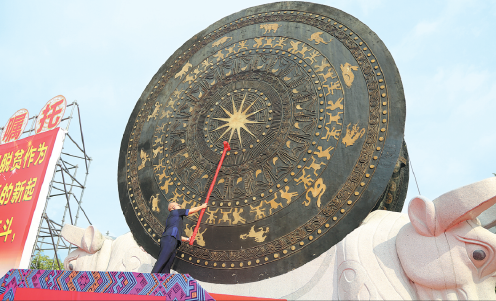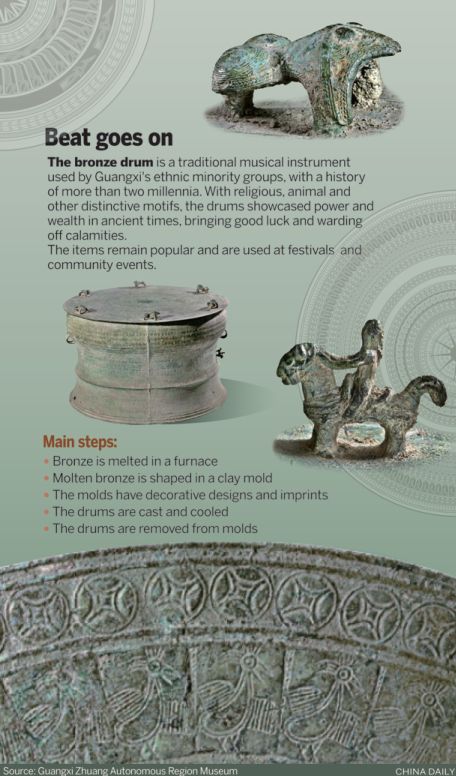Resounding through the ages

The biggest bronze drum in the world is sounded in the public square of the Huanjiang Maonan autonomous county of Hechi, in South China's Guangxi Zhuang autonomous region. Certified by Guinness World Records as the biggest drum of its type, it measures 6.68 meters in diameter and has a depth of 2.88 meters. WEI GUOMAO/FOR CHINA DAILY
Heritage of bronze drums kept alive by ethnic groups
Editor's note: From arts and crafts to knowledge and skills, China's intangible cultural heritage is invaluably embedded in its ethnic communities. This series looks at the latest efforts to preserve and promote the country's inherited traditions and living expressions.
Three years ago, master craftsman Wei Qichu unveiled to the world the largest bronze drum of its kind.
Weighing 50 metric tons, at 6.68 meters across and 2.88 meters deep, the drum took Wei and his team of more than 30 artisans almost a year to forge.
Their masterpiece now stands in the public square of their hometown in the Huanjiang Maonan autonomous county of Hechi, in South China's Guangxi Zhuang autonomous region, with a Guinness World Records certificate recognizing its status.
The achievement marks the growing importance of the bronze drums to ethnic groups in the region, with their casting technique listed as a State-level intangible cultural heritage.
Wei, 58, is a fifth-generation drum maker. He has a 1,200-square-meter workshop in the mountains, a two-hour drive from the county seat, staffed with 10 workers.
"The record drum was certainly a high point for us," he said.
"We've been kept busy since, making traditional drums, ranging from keychain-like miniatures to the common table-sized ones, averaging 100 main drums a month."
The drums are sold not only to members of the ethnic groups, but also to customers from outside the region and overseas.
Ethnic unity
The bronze drum is a traditional musical instrument used by the Zhuang people and other ethnic groups in the region, and has a history of more than two millennia. Its influence extends from Guangxi to neighboring provinces, including Yunnan and Guizhou, and into Southeast Asian countries like Vietnam.
The drums, with their religious, animal and ritual symbols and designs, were used to showcase power and wealth in ancient times and are believed to bring good luck and ward off calamities. Today, they remain popular among the ethnic groups and are used for ceremonial and decorative purposes at festivals and community events.
Hechi is home to over half of the more than 2,400 major bronze drum artifacts recorded worldwide, and many consider the area to be a hub of the traditional heritage.
In late April, President Xi Jinping visited the Anthropology Museum of Guangxi in the regional capital Nanning, where major exhibits of bronze drums are displayed. A highlight of the museum is a rare Western Han Dynasty (206 BC-AD 24) drum with cloud and thunder motifs, weighing 299 kilograms and 165 cm in diameter.
Guangxi is a national demonstration area for ethnic unity and the region should continue to give play to its exemplary and leading role, said Xi, who is also general secretary of the Communist Party of China Central Committee.
During a visit to Guangdong province in October 2020, he also noted that proactive efforts should be made to train inheritors of intangible cultural heritage.
Wu Weifeng, head of the Guangxi Zhuang Autonomous Region Museum, said the bronze drums are the only items of their kind still in use and should be preserved and passed on for future generations. "The ethnic drums can help deepen cultural understanding, strengthening cooperation and exchanges," he said.
From master craftsmen like Wei, to contemporary musicians and educators, Guangxi's ethnic groups are increasingly working toward the protection and promotion of their intangible cultural heritage.
Wei, who is striving to pass on his forging, molding and drum imprinting techniques to a handful of young apprentices, acknowledges the importance of keeping the drums relevant to future generations.
Next generation
When Yao Liang, a musician and teacher at a vocational school in Hechi, approached Wei to customize a set of 13 small bronze drums to help his performances and outreach programs, the craftsman accepted the challenge immediately.
"It was different because we needed to create small drums that suited his tones and needs. But we knew it could help promote our traditions," Wei said.
Yao, 47, who is a member of the Mulam ethnic group, has used his drums to meld and mix traditional and modern music, creating his own popular renditions for music videos and other entertainment platforms to help raise awareness and appreciation of the instrument's heritage.
"I've had international collaboration and performances throughout the country and abroad, including Southeast Asia. These cultural exchanges have been very rewarding," Yao said.
The efforts and enthusiasm of the music teacher, who has a lower-limb impairment following a military training injury three decades ago, have inspired many people, including his student Lan Baoshi.
Under Yao's guidance and encouragement, 20-year-old Lan, who is visually impaired, plays the piano in performances with his teacher who accompanies him on the bronze drums. The pair perform pieces from the region's iconic musical drama, Liu Sanjie. "I've been to Singapore, Malaysia and Thailand to perform," Lan said. "I want to be a music teacher as well."
As part of their cultural exchange and education programs to bring the heritage of the bronze drums closer to the community, Yao also conducts classes at the local kindergarten.
"I want to give the children an early opportunity to keep in touch with their musical traditions," Yao said.
Most of the 1,130 children at the school are from local ethnic groups including the Miao and Mulam, with many of them able to try their hand at playing Yao's bronze drums, nurturing their interest in the traditional instruments.
"Our students can grasp most of the movements," school principal Wei Hong said.
"They are able to learn and practice the drums, and better value their ethnic heritage."

Beat goes on CHINA DAILY
